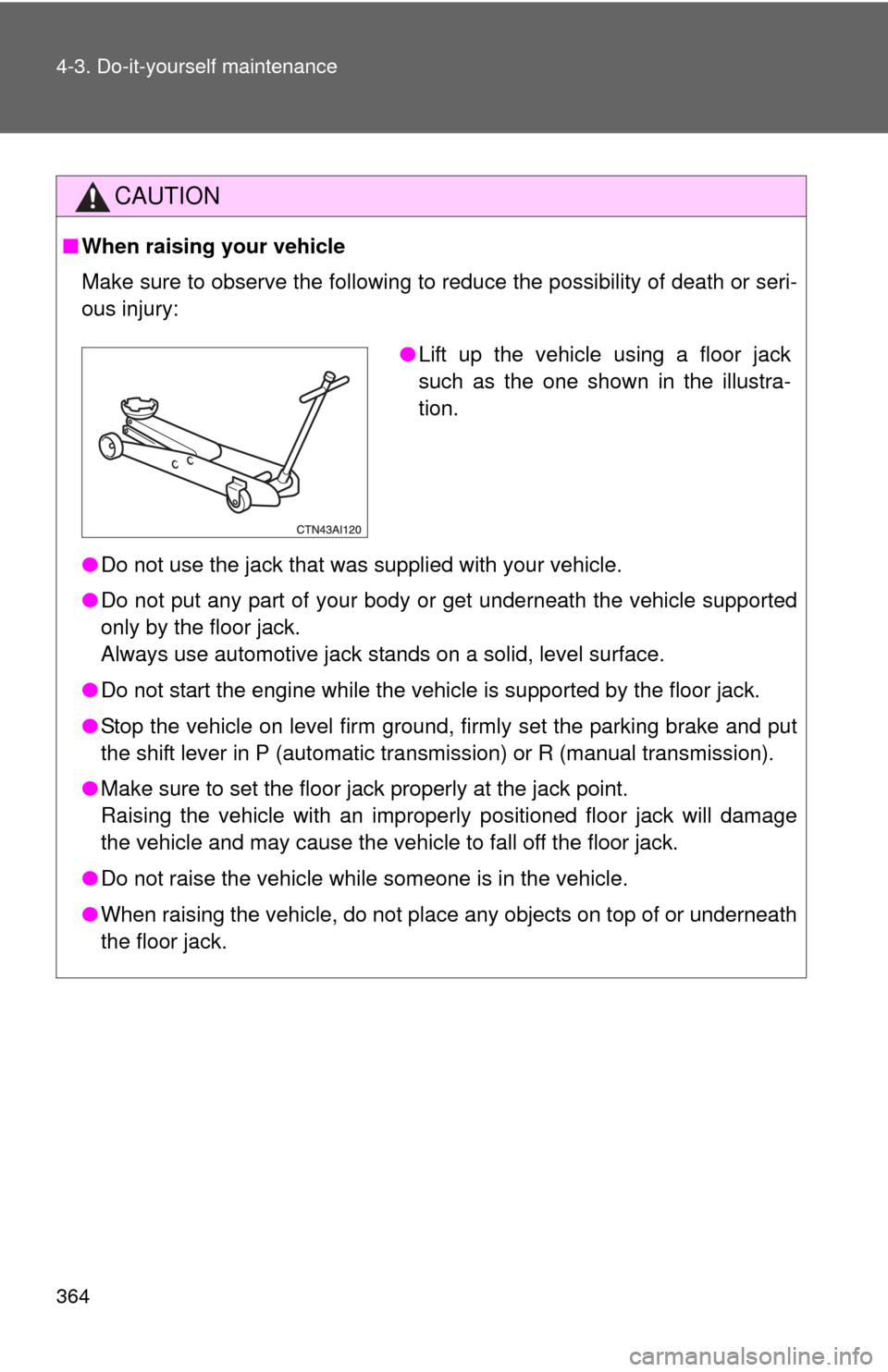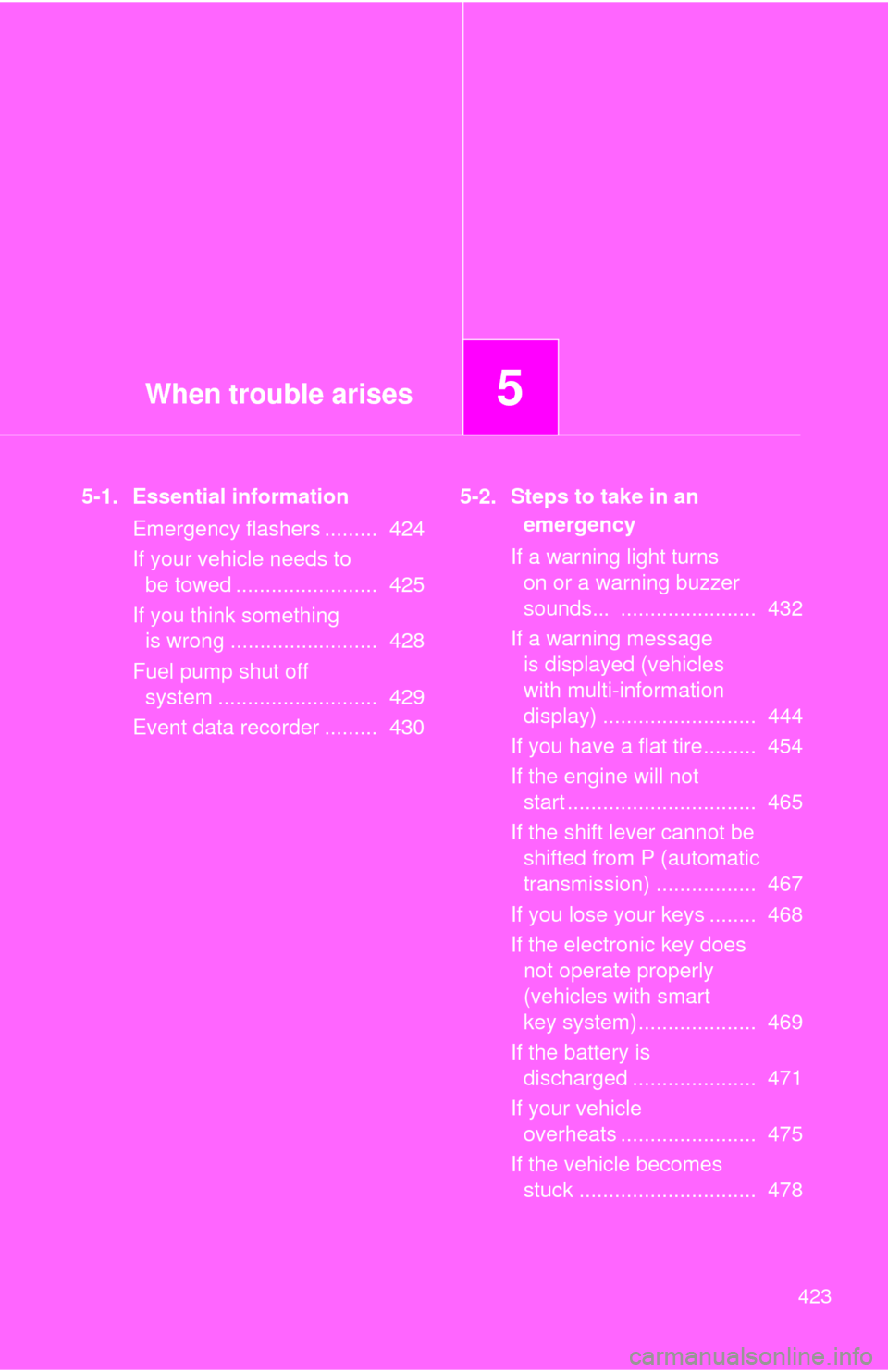Page 358 of 538
356 4-2. Maintenance
Vehicle interior
ItemsCheck points
Accelerator pedal • Moves smoothly (without uneven
pedal effort or catching)?
Automatic transmission “Park”
mechanism • Can the vehicle be held securely
on an incline with the shift lever in
P?
Brake pedal • Moves smoothly?
• Does it have appropriate clear-
ance and correct amount of free
play?
Brakes • Not pull to one side when
applied?
• Loss of brake effectiveness?
• Spongy feeling brake pedal?
• Pedal almost touches floor?
Clutch pedal • Moves smoothly?
Head restraints • Move smoothly and lock
securely?
Indicators/buzzers • Function properly?
Lights • Do all the lights come on?
Parking brake • Moves smoothly?
• Can hold the vehicle securely on
an incline?
Seat belts • Does the seat belt system oper-
ate smoothly?
• Are the belts undamaged?
Seats • Do the seat controls operate
properly?
Steering wheel • Moves smoothly?
• Has correct free play?
• No strange noises?
Page 362 of 538

360 4-3. Do-it-yourself maintenance
CAUTION
The engine compartment contains many mechanisms and fluids that may
move suddenly, become hot, or become electrically energized. To avoid death
or serious injury observe the following precautions.
■When working on the engine compartment
●Keep hands, clothing, and tools away from the moving fan and engine
drive belt.
● Be careful not to touch the engine, radiator, exhaust manifold, etc. right
after driving as they may be hot. Oil and other fluids may also be hot.
● Do not leave anything that may burn easily, such as paper or rags, in the
engine compartment.
ItemsParts and tools
Fuses ( P. 405)Fuse with same amperage rating
as original
Light bulbs ( P. 418)Bulb with same number and watt-
age rating as original
Power steering fluid
level ( P. 376)• Automatic transmission fluid
DEXRON
II or III
• Rag or paper towel
• Funnel (used only for adding power steering fluid)
Radiator and condenser (P. 374)
Tire inflation pressure (
P. 392) • Tire pressure gauge
• Compressed air source
Washer fluid
(P. 381) • Water washer fluid containing
antifreeze (for winter use)
• Funnel
Page 366 of 538

364 4-3. Do-it-yourself maintenance
CAUTION
■When raising your vehicle
Make sure to observe the following to reduce the possibility of death or\
seri-
ous injury:
●Do not use the jack that was supplied with your vehicle.
● Do not put any part of your body or get underneath the vehicle supported
only by the floor jack.
Always use automotive jack stands on a solid, level surface.
● Do not start the engine while the vehicle is supported by the floor jack.
● Stop the vehicle on level firm ground, firmly set the parking brake and put
the shift lever in P (automatic transmission) or R (manual transmission).
● Make sure to set the floor jack properly at the jack point.
Raising the vehicle with an improperly positioned floor jack will damage
the vehicle and may cause the vehicle to fall off the floor jack.
● Do not raise the vehicle while someone is in the vehicle.
● When raising the vehicle, do not place any objects on top of or underneath
the floor jack.
●Lift up the vehicle using a floor jack
such as the one shown in the illustra-
tion.
Page 379 of 538
377
4-3. Do-it-yourself maintenance
4
Maintenance and care
■
Checking the fluid level
Make sure to check the fluid type and prepare the necessary items.
Clean all dirt off the reservoir.
Remove the reservoir cap by turning it counterclockwise and
wipe the dipstick clean.
Reinstall the reservoir cap.
Remove the reservoir cap again and look at the fluid level.
Fluid type Automatic transmission fluid DEXRON II or III
Items Rag or paper towel and funnel (only for adding
fluid)
CAUTION
■
Checking the fluid level
Take care, as the reservoir may be hot.
NOTICE
■When adding fluid
Avoid overfilling, or the power steering may be damaged.
■ After replacing the reservoir cap
Check the steering box case, vane pump and hose connections for leaks or
damage.
STEP1
STEP2
STEP3
STEP4
Page 417 of 538

415
4-3. Do-it-yourself maintenance
4
Maintenance and care
11 PWR
25 A Power windows
12 DOOR NO.2 25 A Main body ECU
13 S/ROOF 30 A Moon roof
14 TAIL 15 AFront side marker/parking lights,
stop/tail lights, rear side marker
lights, license plate lights, back-up
lights, front turn signal lights, main
body ECU
15 PANEL 7.5 ANavigation system, seat heaters,
emergency flashers, air condition-
ing system, audio system, clock,
glove box light, instrument panel
lights, steering switches, vehicle
stability control system, traction
control system
16 ECU IG NO.1 10 A Main body ECU, windshield wipers
and washer, moon roof, tire pres-
sure warning system, electric cool-
ing fans, auto anti-glare inside rear
view mirror, navigation system
17 ECU IG NO.2 7.5 A Anti-lock brake system, vehicle sta-
bility control system, traction con-
trol system, brake assist system,
shift lock control system, auto-
matic transmission, cruise control
system
18 A/C NO.2 10 AAir conditioning system, rear win-
dow defogger
19 WASH 10 A Windshield wipers and washer
20 S-HTR 20 A Seat heaters
21 GAUGE NO.1 10 A Emergency flashers, charging sys-
tem, multiport fuel injection system/
sequential multiport fuel injection
system, back-up lights
FuseAmpereCircuit
Page 425 of 538

When trouble arises5
423
5-1. Essential informationEmergency flashers ......... 424
If your vehicle needs to be towed ........................ 425
If you think something is wrong ......................... 428
Fuel pump shut off system ........................... 429
Event data recorder ......... 430 5-2. Steps to take in an
emergency
If a warning light turns on or a warning buzzer
sounds... ....................... 432
If a warning message is displayed (vehicles
with multi-information
display) .......................... 444
If you have a flat tire......... 454
If the engine will not start ................................ 465
If the shift lever cannot be shifted from P (automatic
transmission) ................. 467
If you lose your keys ........ 468
If the electronic key does not operate properly
(vehicles with smart
key system).................... 469
If the battery is discharged ..................... 471
If your vehicle overheats ....................... 475
If the vehicle becomes stuck .............................. 478
Page 427 of 538
5
When trouble arises
425
5-1. Essential information
If your vehicle needs to be towed
Before towingThe following may indicate a problem with your transmission. Contact
your Toyota dealer before towing.
● The engine is running, but the vehicle will not move.
● The vehicle makes an abnormal sound.
If towing is necessary, we recommend having your vehicle towed by
your Toyota dealer or a commerci al towing service, using a lift-type
truck or a flat bed truck.
Use a safety chain system for all to wing, and abide by all state/pro-
vincial and local laws.
If towing from the front, the vehic le's rear wheels and axles must be
in good condition. (P. 426)
If they are damaged, use a towing dolly or flat bed truck.
Page 429 of 538
5
When trouble arises
427
5-1. Essential information
Towing with a wheel-lift type truck from the rear
Automatic transmission: Use a
towing dolly under the front
wheels.
Manual transmissions: We rec-
ommend to use a towing dolly
under the front wheels.
When not using a towing dolly,
turn the engine switch to the
“ACC” position and shift the shift
lever to N.
Using a flat bed truckIf you use chains or cables to tie
down your vehicle, the angles
shaded in black must be 45.
Do not overly tighten the tie
downs or the vehicle may be
damaged.
NOTICE
■ To prevent causing serious dama ge to the transmission
(automatic transmission)
Never tow this vehicle from the rear with the front wheels on the ground.
■ To prevent damaging the vehicle (manual transmission)
Do not tow the vehicle when the engine switch is in the “LOCK” position or
key removed.
The steering lock mechanism is not strong enough to hold the front wheel
straight.